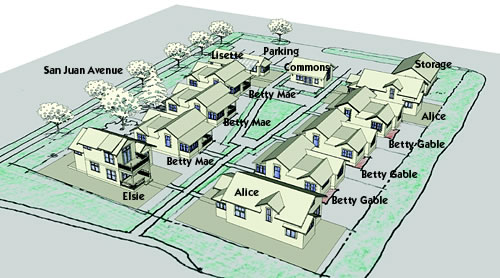I remember way back when I lived in Seattle, in the early 1980s, someone I knew lived in a small detached homes in a cluster of 6 to 8 small homes nestled between Lake Washington and a hillside. They were all rentals, I think, old and not in the best of shape. But the whole thing, the community of small homes, seemed wonderful to me.
Well, an architect in Washington has been creating similar communities, dense clusters of small cottages, in the Puget Sound area. It was written up in Metropolis. Here is the site plan for one of the newest communities, Spring Valley Cottages, located in Port Townsend.
The homes range from 600 to 1,200 square feet and the parking is in an open lot. Prices range from the low $200,000s to the low $400,000s. The architect is Ross Chapin Architects.


